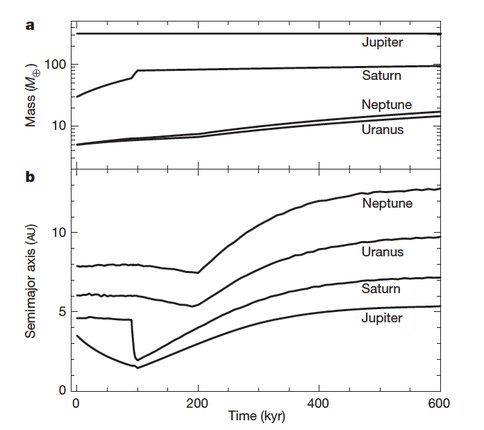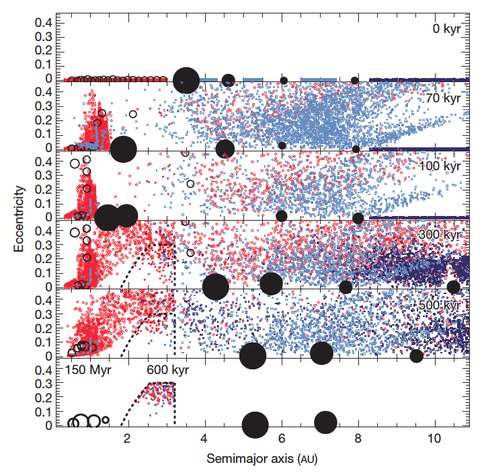2011 Annual Science Report
 VPL at University of Washington
Reporting | SEP 2010 – AUG 2011
VPL at University of Washington
Reporting | SEP 2010 – AUG 2011
Delivery of Volatiles to Terrestrial Planets
Project Summary
This project uses computer models and laboratory work to better understand how volatile materials that are important for life, like water, methane, and other organic molecules, are delivered to terrestrial planets. Habitable planets are too small to gravitationally trap these volatiles directly from the gas disk from which they formed, and instead they must be delivered as solids or ices at the time of the planet’s formation, or ongoing as the planet evolves. These trapped volatiles are eventually released to form our oceans and atmosphere. In this task we use computer models of planet formation and migration to understand how the asteroid belt, which is believed to be the source of the Earth’s oceans, was formed. We also use models to understand what happens to meteoritic material as it enters a planet’s atmosphere, especially where it gets deposited in the atmosphere, what happens to it chemically, and how it interacts with the light from the parent star. .
Project Progress
Co-I Sean Raymond and his collaborators proposed a new model for the early evolution of the Solar System — called the “Grand Tack” — that is characterized by the inward-thenoutward migration of Jupiter in the gaseous protoplanetary disk. If Jupiter’s turnaround point (“tack”) was 1.5 AU then our model can explain both the masses and orbital distribution of the terrestrial planets (including Mars) and the S-type vs C-type dichotomy of the asteroid belt. In the context of this model, Earth’s water was delivered by C-type material from beyond Jupiter’s orbit, that was first implanted into the asteroid belt as part of the migration process.
For much of the year, we have been investigating the fate of meteoritic, organic compounds upon atmospheric entry. We previously found that as exogenous material enters Earth’s atmosphere, organic compounds – including methane, phenol, and styrene – are released at altitudes of 85-110 km. These compounds then undergo reactions in the upper atmosphere that form a more complex molecule containing a para-disubstituted aromatic ring. We extended these studies to explore the entry of organic, meteoric compounds into the atmospheres of other earth-sized planets (masses from 0.1 to 10 Earth masses, and 0.1 to 10 times the earth’s atmospheric pressure). Based on this line of research, we found that the critical factor in the survival of exogenous organics is the altitude at which the material is released. In order to survive, organic material must be released beneath a sufficient amount of atmosphere to block incoming stellar UV. Thus, the stellar UV flux (which is highly dependent on stellar mass rather than planetary properties) is a key factor in determining the fate of incoming organics on earth-like planets. Titan-like planets, i.e those with low masses and thick atmospheres, result in a low-velocity infall, much slower heating rate, and better survival of exogenous organic compounds. Ultimately, detailed atmospheric profiles are critical to determining the altitude at which organics get released during entry.
Figure 1: The radial migration and mass growth imposed on the giant
planets in the reference simulation. a, Mass growth; b, semimajor axis.
A fully-formed Jupiter starts at 3.5 AU, a location expected to be highly favourable for giant planet formation owing to the presence of the so-called snow line. Saturn’s 30 M+ core is initially at ,4.5 AU and grows to 60 M+ as Jupiter migrates inward, over 10^5 years. Inward type-I migration of planetary cores is inhibited in disks with a realistic cooling timescale; thus Saturn’s core remains at 4.5 AU during this phase. Similarly, the cores of Uranus and Neptune begin at ,6 and 8 AU and grow from 5 M+, without migrating. Once Saturn reaches 60 M+ its inward migration begins25, and is much faster than that of the fully grown Jupiter. Thus, on catching Jupiter, Saturn is trapped in the 2:3 resonance3. Here this happens when Jupiter is at 1.5 AU. The direction of migration is then reversed, and the giant planets migrate outward together. In passing, they capture Uranus and Neptune in resonance and these planets are then pushed outwards as well. Saturn, Uranus and Neptune reach their full mass at the end of the migration when Jupiter reaches 5.4 AU. The migration rate decreases exponentially as the gas disk dissipates. The final orbital configuration of the giant planets is consistent with their current orbital configuration when their later dynamical evolution is considered. (From: Walsh, K. J., Morbidelli, A., Raymond, S. N., O’Brien, D. P., & Mandell, A. M. (2011). A low mass for Mars from Jupiter’s early gas-driven migration. Nature, 475, 206-209.)
Figure 2: The evolution of the small-body populations during the growth
and migration of the giant planets, as described in Fig. 1.
Jupiter, Saturn, Uranus and Neptune are represented by large black filled circles with evident inward-then-outward migration, and evident growth of Saturn, Uranus and Neptune. S-type planetesimals are represented by red dots, initially located between 0.3 and 3.0 AU. Planetary embryos are represented by large open circles scaled by M^1/3 (but not in scale relative to the giant planets), where M is mass. The C-type planetesimals starting between the giant planets are shown as light blue dots, and the outer-disk planetesimals as dark blue dots, initially between 8.0 and 13.0 AU. For all planetesimals, filled dots are used if they are inside the main asteroid belt and smaller open dots otherwise. The approximate boundaries of the main belt are drawn with dashed curves. The bottom panel combines the end state of the giant planet migration simulation (including only
those planetesimals that finish in the asteroid belt) with the results of simulations of inner disk material (semimajor axis a<2) evolved for 150 Myr, reproducing successful terrestrial planet simulations. (From: Walsh, K. J., Morbidelli, A., Raymond, S. N., O’Brien, D. P., & Mandell, A. M. (2011). A low mass for Mars from Jupiter’s early gas-driven migration. Nature, 475, 206-209.)
Publications
-
Morbidelli, A., Lunine, J. I., O’Brien, D. P., Raymond, S. N., & Walsh, K. J. (2012). Building Terrestrial Planets. Annual Review of Earth and Planetary Sciences, 40(1), 251–275. doi:10.1146/annurev-earth-042711-105319
-
Pierens, A., & Raymond, S. N. (2011). Two phase, inward-then-outward migration of Jupiter and Saturn in the gaseous solar nebula. A&A, 533, A131. doi:10.1051/0004-6361/201117451
-
Walsh, K. J., Morbidelli, A., Raymond, S. N., O’Brien, D. P., & Mandell, A. M. (2011). A low mass for Mars from Jupiter’s early gas-driven migration. Nature, 475(7355), 206–209. doi:10.1038/nature10201
- Carter, R.T., Jandir, P.S. & Kress, M.E. (2010). Constraining the Drag Coefficients of Meteors in Dark Flight. Meteoroids 2010 Conference.
- Kress, M.E., Belle, C.L., Cody, G.D., Pevyhouse, A.R., Iraci, L.T. & Brownlee, D.E. (2010). Astmospheric Chemistry of Micrometeoritic Organic Compounds. Meteoroids 2010 Conference.
- Pevyhouse, A.R. & Kress, M.E. (2010). Modeling the Entry of Micrometeoroids in the Atmospheres of Earth-like Planets. Meteoroids 2010 Conference.
- Templeton, M. & Kress, M.E. (2010). A Numerical Study of Micrometeoroids Entering Titan’s Atmosphere. Meteoroids 2010 Conference.
-
PROJECT INVESTIGATORS:
-
PROJECT MEMBERS:
Rory Barnes
Co-Investigator
Donald Brownlee
Co-Investigator
Victoria Meadows
Co-Investigator
Thomas Quinn
Co-Investigator
Sean Raymond
Co-Investigator
-
RELATED OBJECTIVES:
Objective 1.1
Formation and evolution of habitable planets.
Objective 3.1
Sources of prebiotic materials and catalysts
Objective 4.1
Earth's early biosphere.
Objective 4.3
Effects of extraterrestrial events upon the biosphere


